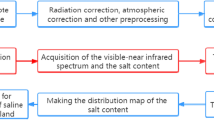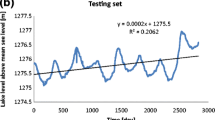Abstract
The shallow seawater depth inversion based on remote sensing technology is important for water depth detection, which is of considerable significance to marine engineering, shipping, and marine military security. In this study, we took the Taiping Island and its adjacent waters in the South China Sea as a test bed and developed a water depth inversion model on the basis of extreme learning machine (ELM) and extreme learning machine optimized by genetic algorithm (GA-ELM). In GA-ELM, the input weights and the hidden layer biases were optimized by genetic algorithm. The two models allowed the evaluation of nonlinear relationships between the reflectance of high-resolution imagery from WorldView-2 and actual water depth obtained from the S-57 sea chart. The eight bands of the high-resolution image and the actual water depth were used as the input layer and the output layer, and the sigmoid function was introduced as activation function. Finally, the model accuracy was evaluated by using mean relative error (MRE), root mean square error (RMSE), mean absolute error (MAE), coefficient of determination (R2), and the regression analysis between the retrieved water depth and the actual data. The simulation results showed that the two models had better stability than the second-order polynomial regression, BP neural network, and RBF neural network. Furthermore, GA-ELM had a more compact network structure and better generalization ability than ELM. Thus, we concluded that GA-ELM had higher precision and could achieve a better inversion result in the experimental area.










Similar content being viewed by others
References
Ceyhun, Ö., & Yalçın, A. (2010). Remote sensing of water depths in shallow waters via artificial neural networks. Estuarine, Coastal and Shelf Science., 89(1), 89–96.
Clark, R. K., Fay, T. H., & Walker, C. L. (1987). A comparison of models for remotely sensed bathymetry (No. NORDA-145). NAVAL OCEAN RESEARCH AND DEVELOPMENT ACTIVITY STENNIS SPACE CENTER MS.
Eugenio, F., Marcello, J., & Martin, J. (2015). High-resolution maps of bathymetry and benthic habitats in shallow-water environments using multispectral remote sensing imagery. IEEE Transactions on Geoscience and Remote Sensing., 53(7), 3539–3549.
Feng, G. R., Huang, G. B., Lin, Q. P., et al. (2009). Error Minimized Extreme Learning MachineWith Growth of Hidden Nodes and Incremental Learning. IEEE Transactions On Neural Networks, 20(8), 1352–1357.
Ghose, D. K., Panda, S. S., & Swain, P. C. (2010). Prediction of water table depth in western region, Orissa using BPNN and RBFN neural networks. Journal of Hydrology., 394(3–4), 296–304.
Han, F., Yao, H. F., & Ling, Q. H. (2013). An improved evolutionary extreme learning machine based on particle swarm optimization. Neurocomputing, 116, 87–93.
Heddam, S. (2016). Secchi disk depth estimation from water quality parameters: artificial neural network versus multiple linear regression models. Environmental Processes, 3(2), 525–536.
Huang, G. B., & Chen, L. (2007). Convex incremental extreme learning machine. Neurocomputing, 70(16–18), 3056–3062.
Huang, G. B., & Chen, L. (2008). Enhanced random search based incremental extreme learning machine. Neurocomputing, 71(16), 3460–3468.
Huang G B, Zhu Q Y, Siew C K. 2005. Extreme learning machine: a new learning scheme of feedforward neural networks// IEEE International Joint Conference on Neural Networks, 2004. Proceedings. IEEE, 2:985–990.
Huang, G. B., Zhu, Q. Y., & Siew, C. K. (2006). Extreme learning machine: Theory and applications Neurocomputing, 70, 489–501.
Huang, G. B., Ding, X. J., & Zhou, H. M. (2010). Optimization method based extreme learning machine for classification. Neurocomputing., 74(1–3), 155–163.
Huang S, Jiang W G, Zhou T G, et al. 2011. Remote sensing of Extracting Water Depth based on Support Vector Machine. In: Proceedings of the 2011 International Conference on Future Computer Science and Application, Intelligent Information Technology Application Association, 381–384.
Kanno, A., Koibuchi, Y., & Isobe, M. (2011). Statistical combination of spatial interpolation and multispectral remote sensing for shallow water bathymetry. IEEE Geoscience and Remote Sensing Letters, 8(1), 64–67.
Lee, Z. P., Carder, K. L., Mobley, C. D., Steward, R. G., & Patch, J. S. (1999). Hyperspectral remote sensing for shallow waters 2 Deriving bottom depths and water properties by optimization. Applied optics, 38, 3831–3843.
Lyzenga, D. R. (1978). Passive remote sensing techniques for mapping water depth and bottom features. Applied Optics, 17(3), 379.
Lyzenga, D. R. (1985). Shallow-water bathymetry using combined lidar and passive multispectral scanner data. International Journal of Remote Sensing, 6(6), 115–125.
Phinn, S. R., Roelfsema, C. M., & Mumby, P. J. (2012). Multi-scale, object-based image analysis for mapping geomorphic and ecological zones on coral reefs. International Journal of Remote Sensing, 33, 3768–3797.
Strome WM, David E. 1990. Modern remote sensing digital image analysis technology for monitoring global change. In:Proceedings of the 23rd international symposium on remote sensing of environment, April 18, 1990-April 25.
Stumpf, R. P., Holderied, K., & Sinclair, M. (2003). Determination of water depth with high-resolution satellite imagery over variable bottom types. Limnology and Oceanography., 48(1 part2), 547–556.
Tian, Q. J., Wang, J. J., & Du, X. D. (2007). Study on water depth extraction from remote sensing imagery in Jiangsu coastal zone. Journal of Remote Sensing, 11(3), 373–379.
Van Hengel, W., & Spitzer, D. (1991). Multi-temporal water depth mapping by means of Landsat TM. International Journal of Remote Sensing, 12(4), 703–712.
Wang, Y. J., & Zhang, Y. (2005). Study on remote sensing of water depth based on BP artificial neural networks. The Ocean Engineering, 9(1), 26–35.
Zheng, G. Z., Chen, F., & Shen, Y. L. (2017). Detecting the water depth of the South China sea reef area from WorldView-2 satellite imagery. Earth Science Informatics, 10, 331–337.
Zheng, G. Z., & Le, X. D. (2017). Inversion of the water depth from WorldView-02 satellite imagery based on BP and RBF neural network. Earth Science, 42, 2345–2553.
Zhu, Y., Zhao, Q., & Zhou, X. D. (2013). Remote sensing water depth inversion based on chaotic immune optimization RBF network. Computer Engineering, 39(5), 187–191.
Author information
Authors and Affiliations
Corresponding author
Additional information
Publisher's Note
Springer Nature remains neutral with regard to jurisdictional claims in published maps and institutional affiliations.
About this article
Cite this article
Zheng, G., Hua, W., Qiu, Z. et al. Detecting Water Depth from Remotely Sensed Imagery Based on ELM and GA-ELM. J Indian Soc Remote Sens 49, 947–957 (2021). https://doi.org/10.1007/s12524-020-01270-w
Received:
Accepted:
Published:
Issue Date:
DOI: https://doi.org/10.1007/s12524-020-01270-w




